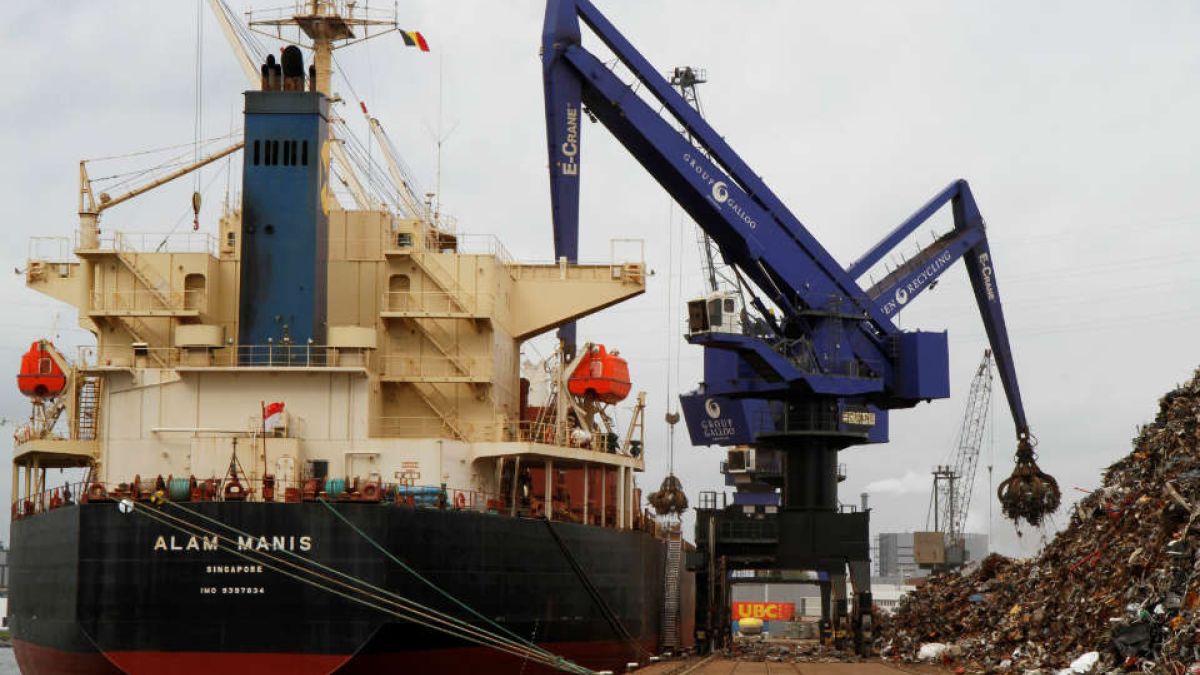
In the Press: E-Crane® makes Galloo Ghent the fastest scrap terminal in the world
GHENT – Through the windows of their office, Chief Executive Officer Bernard Beyne and Managing Director/CEO Rik Debaere of Galloo Recycling Group look out over their scrap terminal with satisfaction. The large, colourful mounds of scrap sit next to each other. It is an unusual view from an office, but that not a cause for concern. Galloo is, after all, doing very well. No less than 15,000 to 20,000 tons of scrap passes through the terminal in Ghent every day, making it the fastest in the world. At the heart of this success story lies the Belgian company, E-Crane®.
In November 2009, the first E-Crane® was installed at Galloo Recycling Group in Ghent. The installation of this performance E-Crane® meant an immediate, rapid and enormous growth in the handling capacity of the export terminal. Thanks to this first E-Crane®, Galloo can continue to handle the ever-increasing amount of scrap effortlessly, and maintain its undisputed leadership position in the ferrous and non-ferrous metal recycling sector.
On a European scale, Galloo Recycling Group belongs at the very top. Its various sites handle more than 2 million tons of ferrous metal per year. All the recycled metal is destined for the steel industry.
Loading time less than 48 hours
At the Galloo Recycling Group site, they are getting ever increasing volumes of scrap, and the management is considering buying another E-Crane®. Towards the end of 2012, E-Crane® (the Belgian company which builds the cranes has the same name as the cranes themselves) received an order for a second E-Crane®. Once again, Galloo Recycling Group chose a type 2000-series crane. The acquisition of an extra E-Crane® resulted in further time-saving; the handling operations at the Ghent site are now even faster. The flexibility of the E-Crane® means that the scrap can be deposited neatly in 25-metre-high mounds. This means that when a handymax ship moors at the Galloo Recycling Group’s wharf in Ghent, loading can begin immediately. This can take less than 48 hours when using an E-Crane®.
“With our old cable cranes we couldn’t get into the corners of the holds which made loading and unloading problematic”, explains CEO Rik Debaere. “With the E-Crane®, the scrap can be spread out better and we have to do less trimming, which, of course, saves a lot of time.We had to stick to our guns to convince the local management to purchase another E-Crane®” continues CEO Rik Debaere. “We had, after all, worked for a long time with hire cranes. I promised a time-saving of 25 percent; I was therefore delighted to discover that we could actually load 50 percent faster than with the old hire cranes.”
Ghent is the port which tranships the most scrap in Belgium. Five years ago, when Galloo was the only scrap exporter in the Port of Ghent, there was a volume of 700,000 tons per year. Of the 1.5 million tons of scrap coming through the port of Ghent, 850,000 tons is handled by Galloo.
Eight E-Crane’s
At Galloo Recycling Group, the two type 2000-series E-Crane’s discharge about 3 vessels per week. Once a month, the two giant cranes work in tandem and load a 30,000 – 40,000 deep-sea vessel. In total, Galloo Recycling Group has 8 cranes. One of the machines, built in 2003 and used to fill the scrap shears, has some 48,000 hours on the meter, and is still running well. The oldest of the E-Cranes used by the Galloo Recycling Group is in operation at the site of the headquarters in Menen. This sturdy and reliable E-Crane® has been used for 25 years to load scrap into the scrap shredder. We’re talking top quality here.
Flemish know-how
In 1998 the first self-made E-Crane® arrived on the market. Right from the start, E-Crane® knocked other cranes out of the no.1 position with its balanced arm operation for the transhipment of scrap, bulk, coal, gravel and sand. E-Crane® is active on a global scale, in both small, inland ports as well as the big ports where Panamax vessels of up to 80,000 tons can be loaded using their popular cranes. The company has subsidiaries in the Netherlands and America, and carries out some 20 crane projects per year.
“Our strength is that we have evolved organically, very gradually and carefully, without growing pains”, says Managing Director Lieven Bauwens. “Our success is based on three fundamentals: flexibility, concerted specialisation and the fact that we are at the top of a niche market. It is nice to think that we have achieved it all with Flemish know-how.” In 2012, E-Crane® took over the Polish steel construction company Famaba. Since then, the steel construction of the cranes has been carried out in-house.
Logistic optimisation and training centre
Cranes made by E-Crane® sell like hot-cakes worldwide. This results in an average turnover of 20 million euro. Success of this calibre requires a solid logistic approach. “During the last two years we have been optimising our warehouse in Adegem. This has even lead to a new entity: E-Crane® Parts & Services”, says MD Lieven Bauwens. “With our new warehouse-platform, we can optimise our after-sales service and we have access worldwide to the necessary parts. Furthermore, E-Crane® Parts & Services is regulated by a software program which we developed ourselves.” Besides a new warehouse-platform, E-Crane® also has a new training centre. “Our E-Crane® Academy allows us to teach new colleagues the tricks of the trade, to keep our people up to date with the latest knowledge and to organise courses for our clients”, confirms MD Lieven Bauwens.
Source: M-text